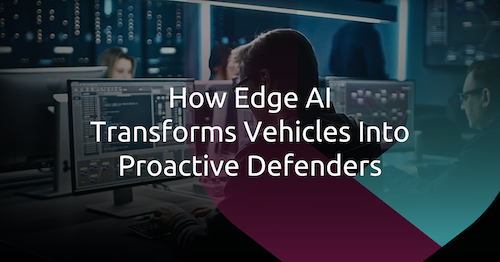
By Gregor Knappik (Senior Cybersecurity Solution Architect) and Ling Cheng (Senior Product Marketing Manager)
根據 Gartner® 發布的《連網車市場預測:機會聚焦》報告:「到 2032 年,具備嵌入式遠端通訊控制單元(TCU)的車輛產量將從 2024 年的 4.85 億輛增長至 8.52 億輛。」* 然而,我們的威脅情報監測顯示,車輛網路安全威脅已在短短四年間激增了 600%。隨著越來越多的連網車輛上路,要診斷的問題變得更加複雜,並且帶來了嚴重的安全風險。目前過度依賴雲端的偵測與回應方式進一步加劇了這些問題,帶來下面的三個重大挑戰:
- 傳輸成本不斷上升:目前的車輛網路安全多依賴將大量資料上傳到車輛安全營運中心(VSOC),隨著車隊規模擴大,成本會大幅增加。當數百萬輛車傳輸數據以進行分析,光是雲端傳輸費用每月就高達 210 萬美元,造成巨大的財務壓力。如何減少將不必要的安全事件傳輸至 VSOC已成為當務之急。
- 難以區分網路攻擊或是系統故障:隨著車輛加入更多的軟體應用,傳統以硬體為核心的汽車產業在故障排除上變得愈發困難。汽車製造商(OEM)與供應商經常難以分辨網路攻擊還是系統異常。例如,如果車前燈在夜間突然失效,製造商可能只關注機械問題,而忽略了網路攻擊的可能性,導致延遲解決並危及駕駛的安全。
- 網路威脅應變延遲:軟體定義車輛(SDV)雖然能夠持續更新功能,但頻繁的功能變更也導致 VSOC 必須承擔不斷調整異常偵測機制,增加了人力的依賴。此外,當車輛連線受阻時,數據無法即時傳輸,這樣的延遲可能導致攻擊未被及時發現,進一步加劇風險,危害車隊與駕駛安全。
車輛其實可以不必完全依賴遠端團隊來確保安全
隨著汽車產業朝向 AI 驅動的軟體定義車輛發展,一個關鍵問題浮現:有什麼創新方法可以解決上述挑戰?
這個願景是讓車輛能夠獨立處理較簡單的問題,將資料數據傳輸分享到雲端 VSOC 團隊之前,能先把這些資料精煉完善與整合。透過 Edge AI(邊緣人工智慧),車輛將具備學習、辨識威脅,甚至在必要時自主防禦的能力。換句話說,每輛車都配備了一個入門級的 VSOC基本功能,並且無縫整合到車輛架構之中。
透過在邊緣設備嵌入威脅偵測功能,車輛能夠關聯來自多個電子控制單元(ECU)的遙測數據與安全事件,例如入侵偵測系統(IDS)標記出數據或是事件的異常狀態。這種整合能將零散的數據資訊轉化為情境話、有脈絡的攻擊路徑,並在邊緣端利用高速運算資源(如 CPU、NPU 或 GPU)處理。接著,這些具備上下文的情報將與實際案例及威脅情報進行交叉比對,使車輛能夠在可疑惡意行為升級之前偵測到它。
圖 1. 邊緣 AI 將 VSOC 能力帶入車輛,直接在車內實現就地威脅偵測與回應。
以Edge AI 偵測有什麼好處?
在車輛中內建智慧功能,它們將不再只是「連網」,而是變得更具彈性與適應性的車子。Edge AI 偵測的主要優勢包括:
- 降低車輛運行成本:透過最大限度地減少對雲端的依賴,Edge AI 可降低成本,並確保數據資料留存在車內且保持安全。此外,資料傳輸的減少可提升 VSOC 的運作效率,將低營運成本。
- 減少車輛停機時間:Edge AI 可直接在車內分析數據,辨識網路威脅的同時,也能偵測潛在的系統或是 ECU 異常,甚至駕駛人的異常行為。這個功能有助於支援預測性維護,降低停機時間,和提高車輛可靠性。
- 降低整合與維護成本:傳統分散式網路安全策略通常需針對各種硬體與軟體系統、和一些要求進行高度客製化。開發的功能越多,驗證需求就越高。Edge AI 透過將網路安全功能集中在支援邊緣AI 的 ECU以簡化整合過程,將低了對其他 ECU 的實作需求。
圖 2. 邊緣 AI 透過將網路安全功能集中,得以降低整合與維護成本。
- 提升 VSOC 團隊效率:借助 Edge AI就僅傳送關鍵偵測結果至 VSOC 團隊,避免 VSOC 被各式零散且無法採取行動的數據資料淹沒。這種簡化的方法可讓 VSOC 團隊專注於需要優先處理的重要威脅,確保獲得的可操作的情報,以更快、更有效的回應來處理問題。
這些優勢正是 VicOne 開發 xCarbon Edge AI(專利申請中)技術的核心動機。順應邊緣運算的發展趨勢,xCarbon Edge AI 為生產 20 年以上的車輛、卡車及巴士等提供卓越的後裝安全優勢。這項創新技術使車輛不僅能應對威脅,還能積極防禦,徹底改變我們對汽車網路安全的思維。
*Gartner,《連網車市場預測:機會聚焦》,Jonathan Davenport,2024 年 10 月 18 日。(僅限 Gartner 訂閱者)GARTNER 是 Gartner, Inc. 及相關企業在美國與全球的註冊商標與服務標誌,經授權得在此使用。版權所有。